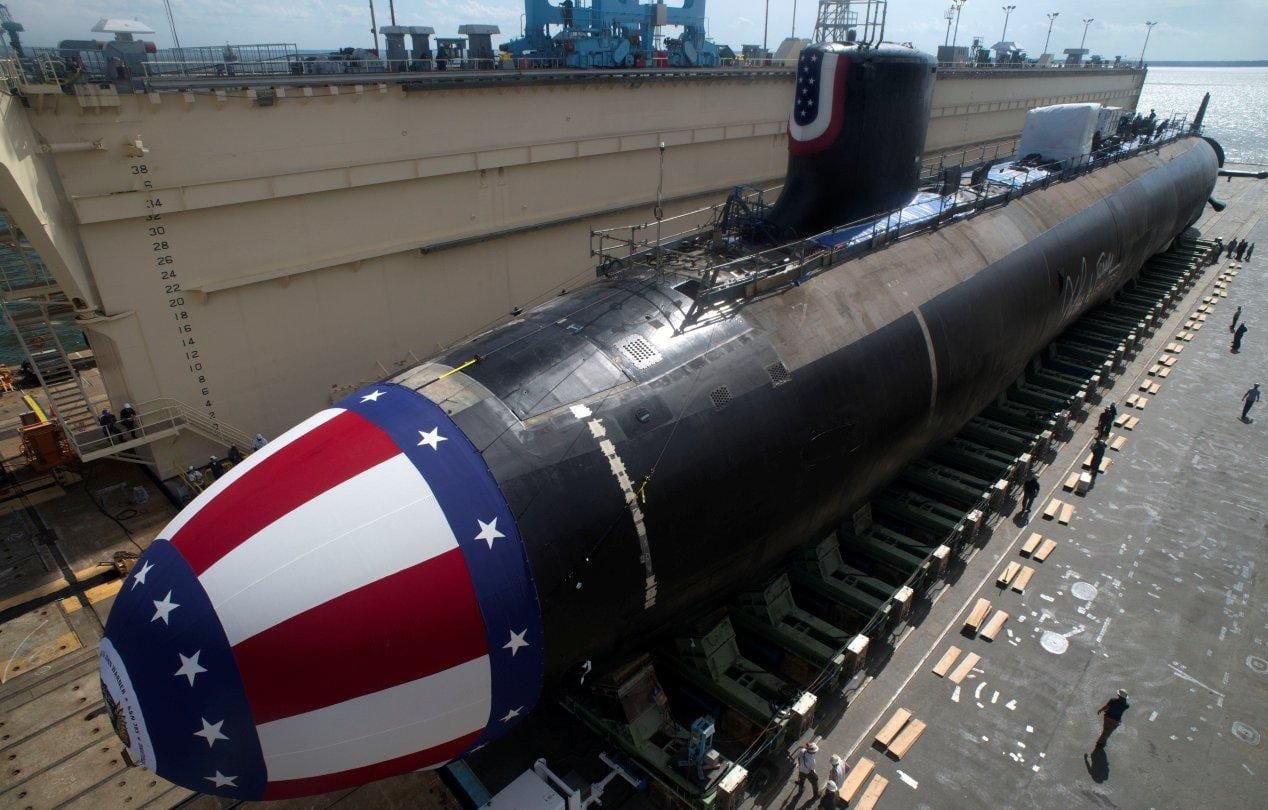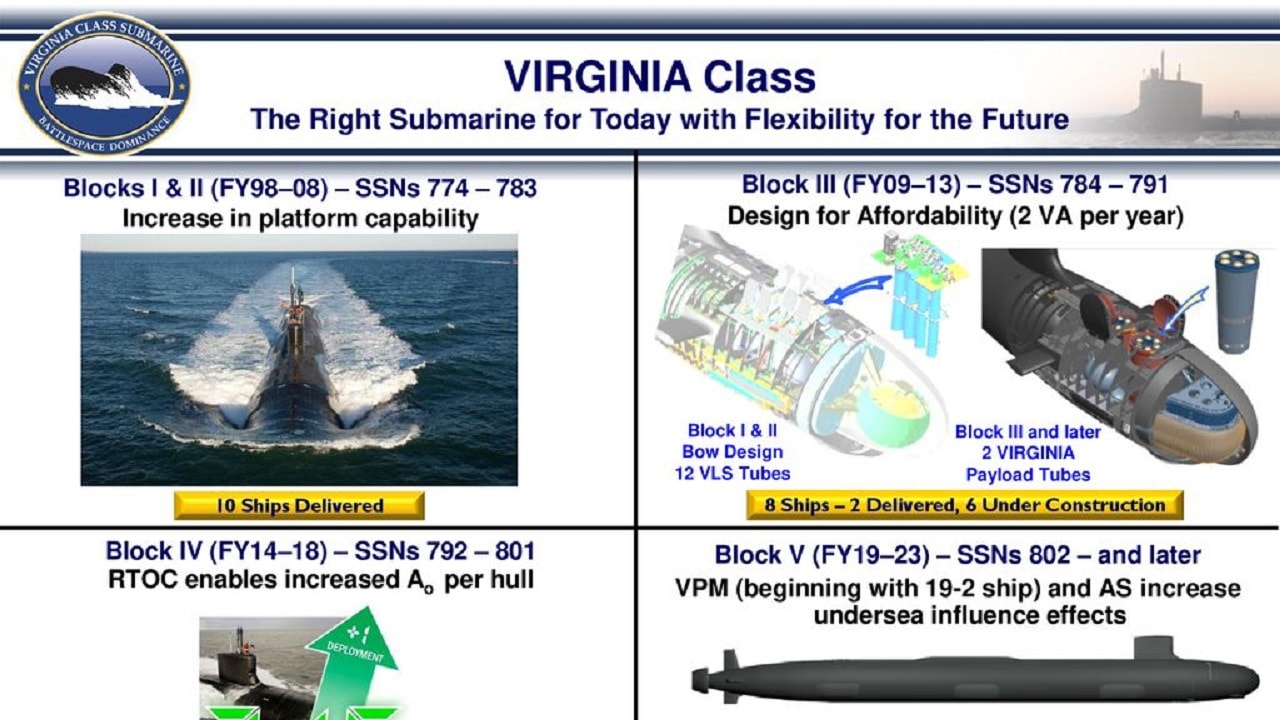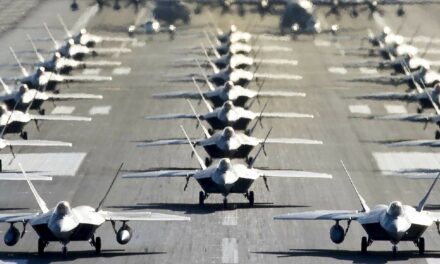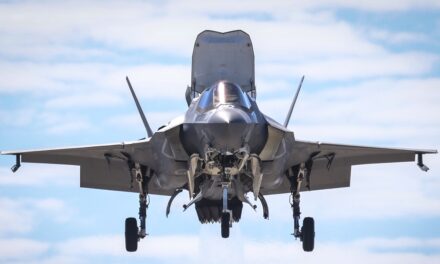We support our Publishers and Content Creators. You can view this story on their website by CLICKING HERE.
Key Points: The Virginia-class Block V submarines are a critical asset for the U.S. Navy, offering enhanced capabilities for modern warfare.
-These submarines, equipped with the Virginia Payload Module, triple the number of Tomahawk cruise missiles compared to earlier variants, making them formidable in fast-attack, anti-submarine, and intelligence missions.
-With advanced stealth features, cutting-edge sonar systems, and potential for hypersonic weapon integration, Block Vs are integral for operations in regions like the Indo-Pacific and the Middle East.
-However, production delays, recruitment challenges, and budget constraints pose hurdles to maximizing their deployment potential.
Virginia-Class Block V: The U.S. Navy’s Stealth Weapon Against China
The U.S. Navy has one of the best if not the best submarine service in the world.
One of the jewels in the undersea warfare branch’s crown is the Virginia-class Block V fast attack subs. The Block Vs feature the Virginia Payload Module, which gives the sub even more deadly Tomahawk cruise missiles – around three times as many.
The subs are likely patrolling in the Middle East and in the Indo-Pacific today – always ready if the United States enters into conflict in those areas of operations.
Virginia-class Block Vs cost $1.8 billion per sub, an eye opening amount, but that is actually one billion dollars cheaper than the Seawolf-class.
The nuclear-powered Virginia-class Block Vs are produced in Groton, Connecticut.
Virginia-Class: Big and Full of Weapons
These subs are 460 feet long – the second longest submarine in the U.S. fleet and shorter than the Ohio-class by 100 feet. Block Vs have a more significant displacement from 7,800 tons to 10,200 tons than earlier iterations of the Virgnia-class.
The Block Vs are armed to the gills. Original Virgnia’s could carry up to 37 torpedoes or Tomahawk missiles. Twelve of the slots are known as Virginia Payload Tubes.
US Navy Virginia-class Submarine Under Construction.
The Block Vs have 28 slots for the Virginia vertical launch systems, each carrying seven Tomahawk cruise missiles. That means 76 percent more space for weapons launches.
According to Naval News, “the submarines will still have the regular torpedo room (weapons stowage compartment). This can carry the latest versions of the ADCAP (Advanced Capability) family of heavyweight torpedoes. They are also likely to carry the new Hammerhead mine which will replace the legacy Mk.47 submarine launched mobile mine (SLMM).”
The Most Modern Tomahawk Missiles
Block Vs employ the latest version of the Tomahawk missile that features not only land attack capabilities but also an anti-ship model. This makes the Block V sub even more deadly. The Block Vs could even launch hypersonic weapons someday. They can currently deploy unmanned underwater vehicles.
Multi-Mission Set
That is just the fast attack mode capabilities. Block Vs can also conduct anti-submarine activities and intelligence missions. The Block Vs have improved noise cancellation and lesser acoustic signature to be quieter than Russian and Chinese submarines.

Image of Virginia-class Submarine. Image Credit: Creative Commons.
The Block Vs will have a better sonar system known as the Large Vertical Array (LVA) flank sonars to work in tandem with the Light-Weight Wide Aperture Arrays (LWWAA).
Order of Naval Battle
The Virginia-class Block Vs are integral to 21st-century warfare. While the Chinese have the largest navy in the world, they cannot compete with American submarines. Any move by China on Taiwan (depending on the president’s orders) could see a shock and awe display by the Virginia-class that would target China’s own shore-based anti-ship missile launchers and aircraft carriers.
There Are Some Downsides
That’s why the United States needs as many new Block V submarines as possible. This construction is limited by budget constraints and lack of shipbuilding personnel. Indeed, there have been production delays on certain upgrades. The navy also needs to train more sailors to crew the Block Vs, always a challenge with the recruiting difficulties that the U.S. military faces.
Special Operations On Tap
If those obstacles can be overcome, the navy has an obvious advantage when it comes to undersea warfare and if the mission is not kinetic, the Block V can conduct counter-insurgency and counter-terror operations by inserting SEAL teams with SEAL Delivery Vehicles in contested environments. The SEALs can also collect intelligence, surveillance, and reconnaissance data on land to prepare for amphibious operations conducted by the U.S. Marine Corps.

(FY98–08) – SSNs 774 – 783. Block III (FY09–13) – SSNs 784 – 791. Increase in platform capability. Design for Affordability (2 VA per year) Block I & II Bow Design. 12 VLS Tubes. Block III and later 2 VIRGINIA Payload Tubes. 10 Ships Delivered. 8 Ships – 2 Delivered, 6 Under Construction. Block IV (FY14–18) – SSNs 792 – 801. Block V (FY19–23) – SSNs 802 – and later. RTOC enables increased Ao per hull. VPM (beginning with 19-2 ship) and AS increase undersea influence effects. 10 Ships – 5 Under Construction, 5 Under Contract. In Design Phase, FY19 Construction Start. 16.
With all of these advantages, Block V Virginia-class is a powerful class of submarines. They can run silently and deep. They can fire multiple land-attack and anti-ship missiles, harass enemy shipping with torpedoes, send SEALs to shore, and gather intelligence on the maritime order of battle.
Block Vs are worth the price and effort. They will be a key asset if the United States ever enters combat in East Asia against China.
About the Author: Dr. Brent M. Eastwood
Brent M. Eastwood, PhD, is the author of Don’t Turn Your Back On the World: a Conservative Foreign Policy and Humans, Machines, and Data: Future Trends in Warfare, plus two other books. Brent was the founder and CEO of a tech firm that predicted world events using artificial intelligence. He served as a legislative fellow for U.S. Senator Tim Scott and advised the senator on defense and foreign policy issues. He has taught at American University, George Washington University, and George Mason University. Brent is a former U.S. Army Infantry officer. He can be followed on X @BMEastwood.

 Conservative
Conservative  Search
Search Trending
Trending Current News
Current News 





